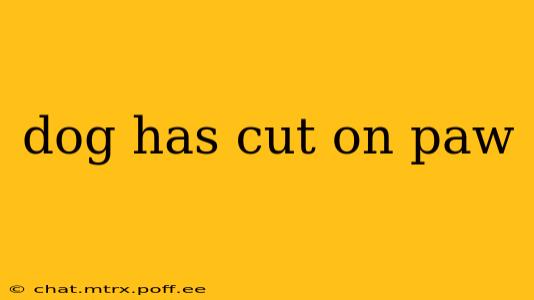A cut on your dog's paw can be a distressing experience for both you and your furry friend. From minor scrapes to deeper wounds, knowing how to assess, treat, and prevent paw injuries is crucial for your dog's well-being. This guide provides a comprehensive overview of dealing with paw injuries in dogs, answering common questions and offering expert advice.
How Do I Know If My Dog's Paw Cut Needs Veterinary Attention?
Determining the severity of your dog's paw injury is the first step. Minor cuts, superficial scrapes, and small punctures might heal on their own with proper cleaning and care. However, you should seek veterinary attention if:
- The cut is deep or bleeds profusely: Deep wounds require professional cleaning and stitching to prevent infection and ensure proper healing.
- The cut is on a joint or near a tendon: These areas are more susceptible to infection and require careful evaluation.
- Your dog is limping excessively or showing signs of pain: Severe pain or reluctance to use the paw indicates a more serious injury.
- The wound shows signs of infection: Look for redness, swelling, pus, or a foul odor.
- You see embedded debris in the wound: Foreign objects need to be removed professionally to prevent infection.
- Your dog is licking the wound excessively: Constant licking can irritate the wound, hindering healing and increasing the risk of infection.
What Should I Do If My Dog Cuts Its Paw?
For minor cuts, follow these steps:
- Clean the wound: Gently rinse the paw with lukewarm water and a mild antiseptic soap. Avoid using hydrogen peroxide or alcohol, as these can damage the tissue.
- Remove any visible debris: Carefully remove any dirt, grass, or other foreign material. Tweezers can be helpful, but avoid digging too deep.
- Apply a topical antibiotic ointment: A thin layer of a veterinary-approved antibiotic ointment can help prevent infection.
- Bandage the paw (if necessary): A bandage can protect the wound and keep it clean, but ensure it's not too tight to restrict circulation. Consider using a pet-specific bandage or sock to prevent your dog from removing it.
- Monitor the wound: Check the paw daily for signs of infection or complications.
How Can I Prevent My Dog From Cutting Its Paws?
Prevention is key when it comes to paw injuries. Here are some tips:
- Regularly check your dog's paws: Inspect your dog's paws regularly for cuts, punctures, or embedded objects. This is especially important after walks, especially in areas with rough terrain or debris.
- Keep your dog's nails trimmed: Long nails can make your dog more prone to injuries.
- Use paw protection: Consider using dog boots, especially when walking on rough surfaces or in harsh weather conditions.
- Be mindful of the environment: Avoid walking your dog on hot pavement or surfaces with sharp objects.
- Be cautious with snow and ice: Salt and chemicals used to de-ice roads can irritate your dog's paws.
My Dog Is Licking Its Paw Wound - Is This Normal?
Excessive licking is a common concern. While a little licking is natural, constant licking can hinder healing and introduce bacteria. A veterinary-approved bitter-tasting spray or Elizabethan collar (cone) can help deter your dog from licking the wound. If the licking is persistent, consult your veterinarian, as it might indicate discomfort or underlying issues.
How Long Does It Take for a Dog's Paw Cut to Heal?
Healing time varies depending on the severity of the wound. Minor cuts may heal within a few days to a week, while deeper wounds may take several weeks or longer. Regular monitoring and proper care are crucial to ensure optimal healing. If you notice any signs of delayed healing or infection, consult your veterinarian immediately.
When Should I Take My Dog to the Emergency Vet for a Paw Injury?
Seek immediate veterinary attention if your dog shows any signs of severe pain, profuse bleeding, or if the wound appears to be seriously infected (e.g., significant swelling, pus, intense redness). Do not delay if you are concerned about the severity of the injury. Your veterinarian can provide the best assessment and treatment plan for your dog.
Remember, this information is for general guidance only. Always consult with a veterinarian for diagnosis and treatment of any injury your dog sustains. Their expertise ensures your dog receives the best possible care and a swift recovery.
